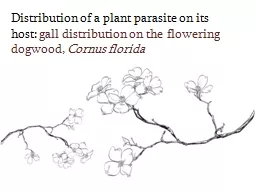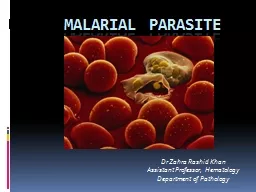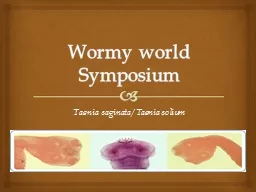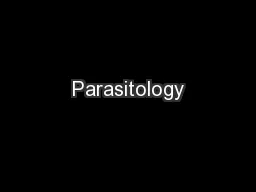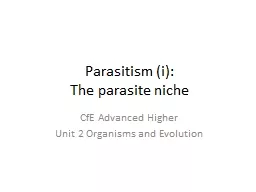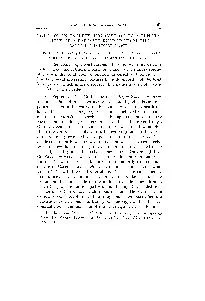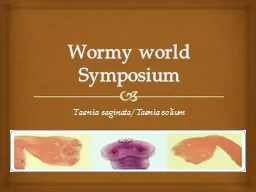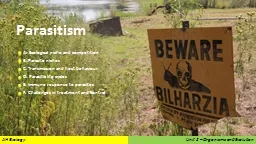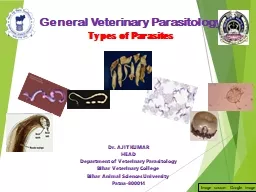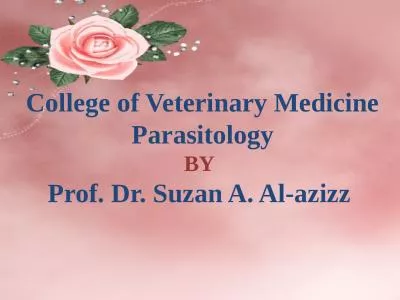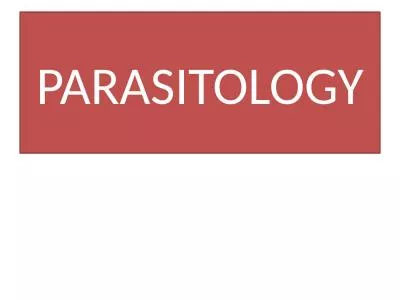PPT-Distribution of a plant parasite on its host:
Author : tatiana-dople | Published Date : 2017-04-26
gall distribution on the flowering dogwood Cornus florida Purpose To determine the distribution of midge galls on dogwood trees and to investigate some environmental
Presentation Embed Code
Download Presentation
Download Presentation The PPT/PDF document "Distribution of a plant parasite on its ..." is the property of its rightful owner. Permission is granted to download and print the materials on this website for personal, non-commercial use only, and to display it on your personal computer provided you do not modify the materials and that you retain all copyright notices contained in the materials. By downloading content from our website, you accept the terms of this agreement.
Distribution of a plant parasite on its host:: Transcript
gall distribution on the flowering dogwood Cornus florida Purpose To determine the distribution of midge galls on dogwood trees and to investigate some environmental factors that might influence distribution. gall distribution on the flowering dogwood, . Cornus. . florida. BIOL3060. Overview. (A) Parasite: . Gall Midge Fly . (. Resseliella. . clavula. ). (B) Host: . Flowering dogwood . (. Cornus. . floria. Dr Zahra Rashid . Khan. Assistant . Professor, . Hematology. Department of Pathology. PARASITE. An . organism that lives in or on another organism (its . host. ) . from . which it obtains . nourishment. Taenia saginata/ Taenia solium. Restate the basic concepts of . parasitology. Define . of the various terms related to basic . parasitology. Discuss . briefly the life cycle and pathogenesis of medically important . Kara Cromwell & Bobbi . Peckarsky. Photo: Angus McIntosh. INCREASING PARASITISM. Baetis. . bicaudatus. Gasteromermis. healthy . Baetis. lifecycle. p. arasitized . Baetis. -. mermithid lifecycle. . M. . Saadatian. Introduction to . parasitology. 1. Introduction to . parasitology. . Parasitology. is a type of . SYMBIOSIS. (living together). (Any plant, animal, or . protist. that is . intimately. CfE . Advanced Higher. Unit 2 Organisms and Evolution. SQA . mandatory key information. Parasites tend to have a narrow niche as they have high host specificity and may lead to parasites which are degenerate. They are lacking in structures and organs found in other organisms. . it reduces costs and risks of caring for young.. ants, wasps, birds, fish. Brood parasitism. Cuckoo being . fed by host. Cuckoo catfish. Cuckoo wasp. Parasites can be generalists (uncommon) or specialists in regard to # of host species.. XOTE ON AX INTERESTING CASE OF T\VO GENERA- TIONS OF A PARASITE REARED FROM THE SAME INDIVIDUAL HOST. BY P. H. TIJIBERLAKE, U. S. DEFT. AGRICULTURE, BUREAU 01; ENTO- IIOLOGI-? CEREAI, Restate the basic concepts of . parasitology. Define . of the various terms related to basic . parasitology. Discuss . briefly the life cycle and pathogenesis of medically important . parasites. Apply . Parasitism. A: Ecological niche and competition. B: Parasite niches. C: Transmission and host behaviour. D: Parasitic life cycles. E: . Immune response to parasites. F: Challenges in treatment and control. Bihar Veterinary College. Bihar Animal Sciences University. Patna-800014. General Veterinary Parasitology. Types of Parasites. Image source: Google image. Types of Parasites. Endoparasite. : . the parasites live within or inside the body of the host.. PRESENTED BY SAIMOUN. INTRODUCTION. . Parasite. :- A living organism which receives nourishment and shelter from another organism where it lives .. . Classes of parasites . :-. . a. . Ecto-parasite. Parasitology . BY. Prof. Dr. Suzan A. Al-azizz. Nomenclature of Parasites:. Each parasite possesses two names, a generic and a specific that the former begins with an initial capital and the latter with an initial small letter, after which comes the designator's name followed by punctuation and finally the year. The generic and specific names are in italics but not the designator's name. For example:. Protozoa and . helminths. (animal parasites) are studied in medical . parasitology. .. Parasite may be classified as :. Ectoparasite. -. . They inhabit the surface of the body of the host without .
Download Document
Here is the link to download the presentation.
"Distribution of a plant parasite on its host:"The content belongs to its owner. You may download and print it for personal use, without modification, and keep all copyright notices. By downloading, you agree to these terms.
Related Documents

